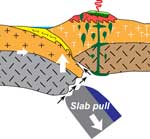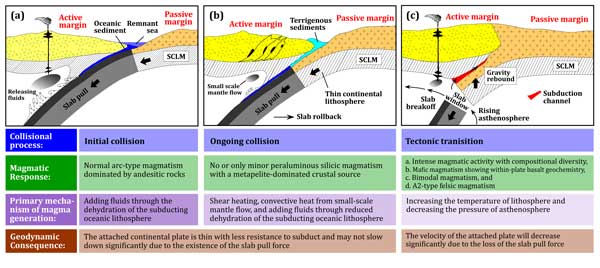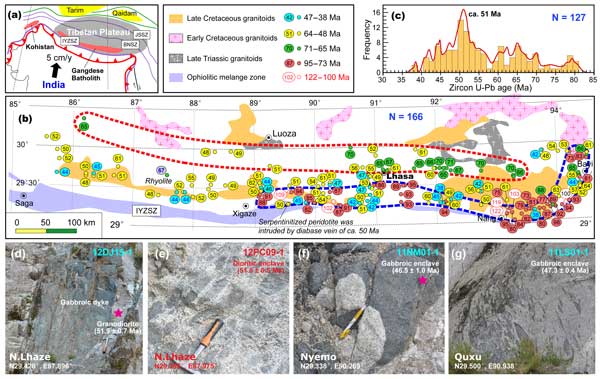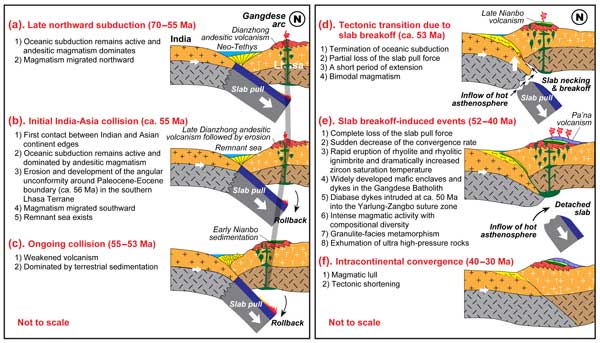 |
Magmatic record of India-Asia collision |
Di-Cheng Zhu1, Qing Wang1, Zhi-Dan Zhao1, Sun-Lin Chung2,3, Peter A. Cawood4,5, Yaoling Niu1,6, Sheng-Ao Liu1, Fu-Yuan Wu7, Xuan-Xue Mo1
1State Key Laboratory of Geological Processes and Mineral Resources, and School of Earth Science and Resources, China University of Geosciences, Beijing 100083, China; dchengzhu@163.com or dczhu@cugb.edu.cn ; qing726@126.com ; zdzhao@cugb.edu.cn ; lsa@cugb.edu.cn ; moxx@cugb.edu.cn
2Institute of Earth Sciences, Academia Sinica, Taipei 11529, Taiwan; sunlin@ntu.edu.tw
3Department of Geosciences, National Taiwan University, Taipei 10617, Taiwan; sunlin@ntu.edu.tw
4Department of Earth Sciences, University of St Andrews, North Street, St Andrews KY16 9AL, UK; pac20@st-andrews.ac.uk
5Centre for Exploration Targeting, School of Earth and Environment, University of Western Australia, 35 Stirling Hwy., Crawley WA, 6009, Australia
6Department of Earth Sciences, Durham University, Durham DH1 3LE, UK, yaoling.niu@durham.ac.uk
7Institute of Geology and Geophysics, Chinese Academy of Sciences, Beijing 100029, China; wufuyuan@mail.igcas.ac.cn
This webpage is a summary of: Zhu, D.-C. et al. (2015) Magmatic record of India-Asia collision. Sci. Rep. 5, 14289; DOI: 10.1038/srep14289.
A petrological approach to distinguish collisional processes
The timing of initial India-Asia collision remains uncertain with suggestions ranging from 70 to 34 Ma. This uncertainty reflects in part the differing approaches used to define collision. A combined understanding of the main driving force of plate tectonics (i.e., slab pull) (Forsyth & Uyeda, 1975; Conrad & Lithgow-Bertelloni, 2002) and the primary mechanisms of magma generation (i.e., adding fluids, increasing temperature, and decreasing pressure) allows us to place constraints on the relationship between collisional processes and magmatic responses in collision zones (Figure 1). This relationship includes:
- Initial collision that is dominated by normal calc-alkaline andesitic magmatism (termed subduction-related or pre-collision magmatism) (Figure 1a),
- Ongoing collision that is characterized by minor peraluminous syn-collisional magmatism (Figure 1b), and
- Tectonic transition that is followed by intense magmatism with compositional diversity (defined here as post-collisional magmatism) as a result of slab breakoff (cf. Davies & von Blanckenburg, 1995; Ferrari, 2004) (Figure 1b).
From initial to ongoing collision, the surface plate may not slow down significantly as the attached continental lithosphere is thin and with less resistance to subduction resulting from the slab pull force. In contrast, after slab breakoff during the tectonic transition the velocity of the surface plate is expected to decrease significantly due to the loss of the slab pull force.
The evolving magmatic record from ongoing subduction to collision, slab breakoff and further continental lithospheric interaction therefore provides a framework to evaluate continent-continent collision. This is because slab breakoff will postdate initial continent-continent collision by several-to-ten million years, depending on convergence velocity, subducting slab dip (cf. Donaldson et al., 2013) and the shape of the colliding margins. Thus, the timing of slab breakoff, which can be identified by integrating geological, geochemical, geochronological, and geophysical data, is an important time-stamp on the sequence of collision-related events.

Figure 1: Schematic sequence of the relationship between collisional processes and magmatic responses in collision zones. (a) Initial collision takes place at the initial contact of crust on two continents. (b) Ongoing collision involves the thin, passive continental lithosphere being dragged by the subducting oceanic lithosphere (slab pull). (c) Tectonic transition occurs as a result of slab breakoff. Click here or on Figure for enlargement.
Example: The India-Asia collision zone, southern Tibet
The Gangdese arc, southern Tibet, records subduction of the Neo-Tethyan oceanic lithosphere and subsequent India-Asia collision. It allows a direct test of our petrological approach to resolving the timing of India-Asia collision. This is because the voluminous Linzizong volcanic rocks (Figure 2) and coeval Gangdese Batholith of the Gangdese arc (Figure 3) range in age from 70 to 40 Ma (cf. Zhu et al., 2013), straddling the interpreted timing of collision.

Figure 2: The Linzizong volcanics in the Lhasa Terrane. (a) The distribution of the Linzizong volcanics in the context of the Tibetan Plateau. IYZSZ = Indus-Yarlung Zangbo suture zone, BNSZ = Bangong-Nujiang suture zone. (b) The distributions, (c) stratigraphic column, and (d), (e), (f), and (g) field photos of the Linzizong volcanics in Linzhou Basin. The filled yellow ovals with numerals are host-rock crystallization ages in Ma using in situ zircon secondary ion mass spectrometry (SIMS) U-Pb dating method. Click here or on Figure for enlargement.
The new SIMS U-Pb zircon age data for 11 samples from the stratigraphic boundaries precisely bracket the duration of each formation of the Linzizong volcanics from the Linzhou Basin: 60.2-58.3 Ma for the Dianzhong Formation, 55.4-52.6 Ma for the Nianbo Formation, and 52.6-52.3 Ma for the Pa’na Formation (Figure 2c). Thus the duration of magmatic activity is some 8 m.y. defined by SIMS zircon U-Pb dating and differs significantly from previous estimates of up to 25 m.y. based on LA-ICPMS zircon U-Pb and Ar-Ar dating for the Dianzhong (69-61 Ma), Nianbo (61-54 Ma), and Pa’na (54-44 Ma) formations (inset, Figure 2b).
A total of 127 samples with LA-ICPMS U-Pb zircon age data from longitude 85-95°E along the strike of the Gangdese Batholith (Figure 3) reveal that the > 72 Ma magmatism was confined to a narrow belt in the south (blue dashed line, Figure 3b), shifting northward at 71-65 Ma (red dashed line), then south at 64-48 Ma. The latter volcanism spread over a broader area than the earlier activity. Finally (47-38 Ma) volcanism was largely restricted to its southern edge. These age data define a pulse of magmatism at ca. 51 Ma along the entire length of the arc (Figure 3c).

Figure 3: The Gangdese Batholith in the Lhasa Terrane. (a) The Gangdese Batholith in the context of the Tibetan Plateau. IYZSZ = Indus-Yarlung Zangbo suture zone, BNSZ = Bangong-Nujiang suture zone, JSSZ = Jinsha suture zone. (b) The distribution of the Gangdese Batholith from longitude 85-94°E. The filled circles indicate sample locations, numerals in ovals are host-rock crystallization ages in Ma using the in situ zircon LA-ICPMS U-Pb dating method. Five groups of zircon ages are recognized on the basis of spatial variation of magmatism and different magmatic origin. (c) Histogram of crystallization ages (Ma) of the intrusive rocks(85-94°E) from the Gangdese Batholith. The red line represents the frequency curve. Age data used in this histogram are the crystallization ages defined by the youngest group of zircon analyses of each sample. The bin width was set at 1.5 Ma to accommodate average age uncertainties of 1.1 Ma (2σ). Only one age datum is selected for each pluton if the between-sample age difference is <3 Ma. If this difference is more than 3 Ma, this pluton is considered to have emplaced in different pulses and thus the different emplacement ages are used to construct the histogram. (d), (e), (f) and (g) are field photos of the intrusive rocks in the Gangdese Batholith. Click here or on Figure for enlargement.
Geochemically, an andesite-dacite association in the Dianzhong Formation was followed by bimodal volcanic suites in both the Nianbo and Pa’na formations, and an increase in zircon saturation temperature at ca. 52 Ma was detected using the rhyolitic rocks in the Pa’na Formation. Whole-rock geochemical data on the 80-40 Ma intrusive rocks from the Gangdese Batholith (85-94°E) reveals felsic-dominated magmatism at 80-73 Ma, followed by significant mafic magmatic activity at 70-43 Ma.
Interpretation
Temporal trends of increasing mafic magmatism and zircon saturation temperature in the Linzizong volcanic rocks and Gangdese Batholith indicate increasing mantle heat input. One possible explanation for this at 70-43 Ma was removal of the Asian lithosphere following tectonic shortening between 90 and 69 Ma (Kapp et al., 2007). However, to account for the southward migration of magmatism from 72-65 Ma to 64-48 Ma (Figure 3b), the rapid eruption of ca. 2 km thick rhyolite and rhyolitic ignimbrite (52.6-52.3 Ma) (Figure 2c), significantly increased zircon saturation temperature at ca. 52 Ma and peak activity at ca. 51 Ma (Figure 3c), we argue for slab steepening (Figures 4a and 4b) and rollback (Figure 4c) followed by slab breakoff (Figure 4d) at ca. 53 Ma. This timing of slab breakoff is consistent with numerical modeling that indicates rapid breakoff (< 2 Ma; Duretz et al., 2012) followed by intense magmatism as a result of enhanced heat input from rising asthenosphere (van de Zedde and Wortel, 2001).
The development of magmatic activity at 51-43 Ma in the Gangdese arc, as well as ca. 50 Ma diabase dykes that intrude serpentinitized peridotite within the Yarlung-Zangbo suture zone (Figure 3b), are most likely consequences of partial melting of differing magma source regions through increasing temperature of lithosphere and decreasing pressure of asthenosphere after slab breakoff. This interpretation agrees with numerical modeling which indicates that hot asthenosphere continues to ascend and generate melt for several million years after slab breakoff (Figure 4e) (van de Zedde & Wortel, 2001). The shift in whole-rock Nd and zircon Hf isotopic compositions towards negative values at ca. 50 Ma most likely reflects a profound change in the source region associated with slab edge materials of the Indian continent that had already been subducted (Figure 4e), rather than initial India-Asia collision (Bouilhol et al., 2013).
The timing of extensive magmatism (ca. 52-51 Ma) in the Gangdese arc matches the sudden reduction in convergence rate of the Indian plate at ca. 51 Ma (Patriat & Achache, 1984; Besse et al., 1984; van Hinsbergen et al., 2011). This synchronicity of events suggests that the slowdown of the Indian plate is largely the consequence of slab breakoff (Figure 4e). This results in the loss of the slab pull force (Davies and von Blanckenburg, 1995; Duretz et al., 2012) which dominates the velocity of the surface plate and a drastic change in plate motion results (Forsyth & Uyeda, 1975; Conrad & Lithgow-Bertelloni, 2002; Austermann et al., 2011). Traditionally, the slow-down of the Indian plate at ca. 51 Ma is attributed to the increased resistance to subduction resulting from initial India-Asia collision (Patriat & Achache, 1984; Besse et al., 1984). This interpretation is questionable because:
- in such a model there are no appropriate mechanisms (Figure 1b) for producing extensive magmatism in southern Tibet (Figures 2 and 3), and
- the surface motion of the plate is closely related to or substantially driven by mantle dynamics (i.e., slab pull) (Forsyth and Uyeda, 1975; Conrad & Lithgow-Bertelloni, 2002; Austermann et al., 2011). Thus, if this driving force disappears, significant slow down occurs.
Any estimates of the timing of the initial India-Asia collision must effectively explain all the first-order observations of spatial, temporal (Figure 3b), and compositional change in magmatic activity. In particular, we must explain the specific geodynamic processes responsible for southward migration of magmatism from 72-65 Ma to 64-48 Ma followed by dramatically enhanced magmatism precisely constrained at ca. 52-51 Ma in the Gangdese arc (Figure 2c) and widely developed mafic enclaves and dykes (ca. 52-47 Ma) (Figures 3d-g) in the Gangdese Batholith. Such enhanced magmatism requires anomalously high-temperature material and heat supply from the mantle, which are unlikely to be explained by later slab breakoff (at ca. 50-40 Ma, 45 Ma, 48-44 Ma, and 50 Ma) predating intense magmatism, or by ca. 50 Ma India-Asia or Tethyan Himalaya-Asia collision (van Hinsbergen et al., 2012) that would result in compression without intense magmatism (Figure 1b).

Figure 4: Schematic illustrations showing India-Asia collisional processes and resultant tectonomagmatic activity over the past 70-40 m.y. (not to scale). Click here or on Figure for enlargement.
The initial India-Asia collisional age of ca. 51-47 Ma proposed from eclogite-facies peak metamorphism (Donaldson et al., 2013) is likely an underestimate because the exhumed ultra-high-pressure rocks may not represent materials from the leading edge of the subducted Indian continental margin. Slab breakoff is likely inevitable in all collision zones involving a passive continental margin (Davies & von Blanckenburg, 1995). It follows that subducted continental crust has reached its maximum depth when slab breakoff occurs. This means that slab breakoff provides a maximal age for continental collision. In the case of the India-Asia collision, if Neo-Tethyan slab breakoff occurs at ca. 53 Ma, the initial India-Asia collision commenced at ca. 55 Ma. This is because the progressively increasing subducting slab dip revealed by the southward migration of magmatism from 72-65 Ma to 64-48 Ma (Figure 3b) and high India-Asia convergence velocity (van Hinsbergen et al., 2011) point to a time lag of ca. 1–2 Ma between initial collision and slab breakoff.
This timing of the initial India-Asia collision (ca. 55 Ma) obtained using our petrological approach is in good agreement with recent estimates of collision ages from sedimentological (58-56 Ma) (Orme et al., 2015; Hu et al., 2015) and paleomagnetic studies (ca. 54.3 Ma; Ma et al., 2014). This collision may account for the angular unconformity between the Dianzhong and Nianbo formations in Linzhou Basin (Figure 2c) and the coeval unconformity found in the Xigaze forearc basin (Hu et al., 2015) due to the locking of the subduction zone on arrival of the Indian continent at the trench (Magni et al., 2012). Nevertheless, we note that the exact timing of initial impingement of the Indian margin with the subduction zone will depend on the degree of extension of the Asian margin and may vary along the strike of the convergence zone due to irregularities in the shape of the margin.
Conclusions
Continental arc magmatism in southern Tibet 80-40 Ma migrated from south to north and then back south with significant mantle input at 70-43 Ma. A pronounced flare-up in magmatic intensity (including ignimbrite and mafic rock) at ca. 52-51 Ma corresponds to a sudden decrease in the India-Asia convergence rate. Geological and geochemical data are consistent with mantle input controlled by slab rollback from ca. 70 Ma and slab breakoff at ca. 53 Ma. We propose that the slowdown of the Indian plate at ca. 51 Ma is largely the consequence of slab breakoff of the subducting Neo-Tethyan oceanic lithosphere, rather than the onset of the India-Asia collision as traditionally interpreted, implying that initial India-Asia collision commenced earlier, likely at ca. 55 Ma.
References
-
Austermann, J., Ben-Avraham, Z., Bird, P., Heidbach, O., Schubert, G., and Stock, J.M. (2011). Quantifying the forces needed for the rapid change of Pacific plate motion at 6 Ma. Earth Planet. Sci. Lett. 307, 289-297.
-
Besse, J., Courtillot, V., Pozzi, J.P., Westphal, M., and Zhou, Y.X. (1984). Palaeomagnetic estimates of crustal shortening in the Himalayan thrust and Zangbo suture. Nature 311, 621-626.
-
Bouilhol, P, Jagoutz, O., Hanchar, J.M., and Dudas, F.O. (2013). Dating the India-Eurasia collision through arc magmatic records. Earth Planet. Sci. Lett. 366, 163-175.
-
Conrad, C.P., and Lithgow-Bertelloni, C. (2002). How mantle slabs drive plate tectonics. Science 298, 207-209.
-
Davies, J.H., and von Blanckenburg, F. (1995). Slab breakoff: A model of lithosphere detachment and its test in the magmatism and deformation of collisional orogens. Earth Planet. Sci. Lett. 129, 85-102.
-
Donaldson, D.G., Webb. A.A.G., Menold. C.A., Kylander-Clark, A.R.C., and Hacker, B.R. (2013). Petrochronology of Himalayan ultrahigh-pressure eclogite. Geology 41, 835-838.
-
Duretz, T., Schmalholz, S.M., and Gerya, T.V. (2012). Dynamics of slab detachment. Geochem. Geophys. Geosyst. 13, Q03020.
-
Ferrari, L. Slab detachment control on mafic volcanic pulse and mantle heterogeneity in central Mexico. Geology 32, 77–80 (2004).
-
Forsyth, D., and Uyeda, S. (1978). On the relative importance of the driving forces of plate motions. Geophys. J. Int. 43, 163-200.
-
Hu, X.M., Wang, J.G., BouDagher-Fadel, M., Garzanti, E., and An, W. (2015). New insights into the timing of the India–Asia collision from the Paleogene Quxia and Jialazi formations of the Xigaze forearc basin, South Tibet. Gondwana Res., doi: 10.1016/j.gr.2015.02.007.
-
Kapp, P., DeCelles, P.G., Leier, A., Fabijanic, J.M., He, S., Pullen, A., Gehrels, G.E., and Ding, L. (2007). The Gangdese retroarc thrust belt revealed. GSA Today 17, 4-9.
-
Ma, Y.M., Yang, T.S., Yang, Z.Y., Zhang, S.H., Wu, H.C., Li, H.Y., Li, H.K., Chen, W.W., Zhang, J.H., and Ding, J.K. (2014). Paleomagnetism and U-Pb zircon geochronology of Lower Cretaceous lava flows from the western Lhasa terrane: New constraints on the India-Asia collision process and intracontinental deformation within Asia. J. of Geophys. Res.: Solid Earth 119, 7404-7424.
-
Magni, V., van Hunen, J., Funiciello, F., and Faccenna, C. (2012). Numerical models of slab migration in continental collision zones. Solid Earth 3, 293-306.
-
Orme, D.A., Carrapa B., and Kapp, P. (2015). Sedimentology, provenance and geochronology of the Upper Cretaceous-Lower Eocene western Xigaze forearc, southern Tibet. Basin Res. 27, 387-411.
-
Patriat, P., and Achache, J. (1984). Indian-Eurasia collision chronology has implications for crustal shortening and driving mechanism of plates. Nature 311, 615-621.
-
van de Zedde, D.M.A., and Wortel, M.J.R. (2001). Shallow slab detachment as a transient source of heat at midlithospheric depth. Tectonics 20, 868-882.
-
van Hinsbergen, D.J.J., Lippert, P.C., Dupont-Nivet, G., McQuarrie, N., Doubrovine, P.V., Spakman, W., and Torsvik, T.H. (2012). Greater India Basin hypothesis and a two-stage Cenozoic collision between India and Asia. Proc. Natl Acad. Sci. USA 109, 7659-7664.
-
van Hinsbergen, D.J.J., Steinberger, B., Doubrovine, P., and Gassmöller, R. (2011). Acceleration-deceleration cycles of India-Asia convergence: Roles of mantle plumes and continental collision. J. Geophys. Res. 116, B06101.
-
von Blanckenburg, F., and Davies, J.H. (1995). Slab breakoff: A model for syncollisional magmatism and tectonics in the Alps. Tectonics 14, 120-131.
-
Zhu, D.C., Zhao, Z.D., Niu, Y.L., Dilek, Y., Hou, Z.Q., and Mo, X.X. (2013). The origin and pre-Cenozoic evolution of the Tibetan Plateau. Gondwana Res. 23, 1429-1454.
last updated 7th
November, 2015 |
